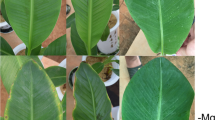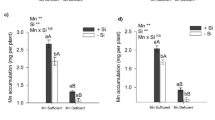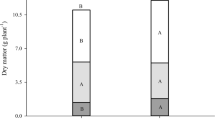Abstract
Magnesium is one of the essential elements for plant growth and cerium is a beneficial element for plant growth. However, the effects of the fact that cerium improves the nitrogen metabolism of plants under magnesium deficiency is poorly understood. The main aim of the study was to determine the role of cerium in the amelioration of magnesium-deficiency effects in spinach plants. Spinach plants were cultivated in Hoagland’s solution. They were subjected to magnesium deficiency and to cerium chloride administered in the magnesium-present media and magnesium-deficient media. Spinach plants grown in the magnesium-present media and magnesium-deficient media were measured for key enzyme activities involved in nitrogen metabolism such as nitrate reductase, nitrite reductase, glutamate dehydrogenase, glutamate synthase, urease, glutamic–pyruvic transaminase, and glutamic–oxaloace protease transaminase. As the nitrogen metabolism in spinach was significantly inhibited by magnesium deficiency, it caused a significant reduction of spinach plant weight, leaf turning chlorosis. However, cerium treatment grown in magnesium-deficiency media significantly promoted the activities of the key enzymes as well as the contents of the free amino acids, chlorophyll, soluble protein, and spinach growth. It implied that Ce3+ could partly substitute for magnesium to facilitate the transformation from inorganic nitrogen to organic nitrogen, leading to the improvement of spinach growth, although the metabolism needs to be investigated further.





Similar content being viewed by others
References
Buchanan BB, Gruissem W, Johones RL (2002) Biochemistry and molecular biology of plants. American Society of Plant Physiology, Science Press, Beijing, pp 568–628
Wu WH (2003) Plant physiology. Science Press, Beijing, pp 93, 105–108, 134–135 (in Chinese)
Briskin DP, Pooler J (1983) Role of magnesium in plasma membrane ATPase of red beet. Plant Physiol 71:969–971
Fisher ES, Bream EE (1993) Influence of magnesium deficiency on rates of leaf expansion, starch and sucrose accumulation, and net assimilation in Phaseolus vulgaris. Physiol Planta 89:271–276
Cakma KI (1994) Activity of ascorbate-dependent H2O2-scavenging enzymes and leaf chlorosis are enhanced in magnesium and potassium deficient leaves, but not in phosphorus-deficient leaves. J Exp Bot 45(278):1259–1266
Cakma KI, Hengeler C, Marschner H (1994) Partitioning of shoot and root dry matter and carbohydrates in bean plants suffering from phosphorus, potassium and magnesium deficiency. J Exp Bot 45:1245–1250
Cakma KI, Hengeler C, Marschner H (1994) Changes in phloem export of sucrose in leaves in response to phosphorous, potassium and magnesium deficiency in bean plant. J Exp Bot 45:1251–1257
Lavon R, Goldshmidt EE, Salomon R (1995) Effect of potassium, magnesium and calcium deficiencies on carbohydrate pools and metabolism in citrus leaves. J Am Soc Hortic Sci 120(1):54–58
Hong FS, Wei ZG, Zhao GW (2002) Mechanism of lanthanum effect on the chlorophyll of spinach. Sci China Ser C 45(2):166–176
Hong FS, Wang L, Meng XX, Wei Z, Zhao GW (2002) The effect of cerium on the chlorophyll formation of spinach. Biol Trace Element Res 89:263–277
Hong FS, Wang XF, Liu C, Su GX, Song WP, Wu K, Tao Y, Zhao GW (2003) Effect of Ce3+ on spectral characteristic of D1/D2/Cytb559 complex from spinach. Sci China Ser B 46(1):42–50
Hong FS, Liu C, Zheng L, Wang XF, Wu K, Song WP, LV SP, Tao Y, Zhao GW (2005) Formation of complexes of rubisco–rubisco activase from La3+, Ce3+ treatment spinach. Sci China Ser B 48(1):67–74
Liu C, Hong FS, Wu K, Ma HB, Zhang XG, Hong CJ, Wu C, Gao FQ, Yang F, Liu T, Xu JH, Xie YN, Li ZR (2006) Effects of Nd3+ ion on carboxylation activity of ribulose-1, 5-bisphosphate carboxylase/oxygenase of spinach. Biochem Biophys Res Comm 342(1):36–43
Meider H (1984) Class experiments in plant physiology. Allen and Unwin, London, pp 72–74
Arnon DI (1949) Copper enzymes in isolated chloroplasts: polyphenol oxidase in Beta vulgaris. Plant Physiol 24:1–15
Richards EJ (1993) Chemical characterization of plant tissue. In: Carter MR (ed) Soil sampling and methods of analysis. Lewis, Boca Raton, pp 115–139
Yemm EW, Cocking EC (1995) Determination of amino acid with ninhydrin. Analyst 80:209–213
Lowry OH, Rosebrough NJ, Farr AL, Randall RJ (1951) Protein measurement with the folin phenol reagent. J Biol Chem 193:265–275
Hageman RH, Flesher D (1960) Nitrate reductase activity in corn seedlings as affected by light and nitrate content of nutrient media. Plant Physiol 35:700–708
Sawhney SK, Naik MS (1973) Role of light in synthesis of nitrate reductase and nitrite reductase in rice seedlings. Biochem J 130:475–485
Boland MJ, Fordyce AM, Greenwood RM (1978) Enzymes of nitrogen metabolism in legume nodules: a comparative study. Aust J Plant Physiol 5:553–559
O’Neal D, Joy KW (1973) Glutamine synthetase of pea leaves I. Purification stabilization and pH optima. Arch Biochem Biophys 159:113–122
Malhotra OP, Indira R (1969) Purification and properties of urease of Cajanus indicus. Indian J Biochem 6:15–20
Tonhazy NE, White NG, Umbriet WW (1950) Colorimetric assay of glutamic–pyruvic transaminase. Arch Biochem Biophys 28:36–38
Polle A, Otter T, Mehne-Jakobs B (1994) Effect of magnesium-deficiency on antioxidative systems in needles of Norway spruce (Picea abies (L.) Karst.) grown with different ratios of nitrate and ammonium as nitrogen sources. New Phytol 128:621–628
Anza M, Riga P (2001) Effect of magnesium deficiency in antioxidant enzymes from pepper plants (Capsicum annuum L.). Acta Horticulturae 559:365–370
Dong B, Wu ZM, Xu L, Gao XX (1992) Effects of LaCl3 on composition of amino acid in plant exudation. Chin Bulletin Bot 9(3):44–46 in Chinese
Eck HV, Wilson GC, Martinez T (1975) Nitrate reductase activity of grain sorghum leaves as related to yields of grain, dry matter and nitrogen. Crop Sci 15:557–560
Srivastava HS (1980) Regulation of nitrate reductase activity in higher plants. Phytochem 19:725–733
Dong B, Wu ZM, Tang YK (1993) The affect of Ce3+ on the physiology of cumber young root under Ca-deficient condition. J Chin Rare Earth 11(1):65–68 in Chinese
Burdygina VS, Kuzin AT (1966) In: Gupta US (ed) Physiological aspects of crop nutrition and resistance. Atma Ram, Delhi
Wellburn AR, Higginson C, Robinson D, Walmsley C (1981) Biochemical explanations of more than additive inhibitory effects of low atmospheric levels of sulphur dioxide plus nitrogen dioxide upon plants. New Phytol 88:223–227
Huang H, Liu XQ, Qu CX, Liu C, Chen L, Hong FS (2008) Influences of calcium deficiency and cerium on the conversion efficiency of light energy of spinach. Biometals 21:553–561
Acknowledgement
This work was supported by the National Natural Science Foundation of China (grant no. 30470150, 30800068).
Author information
Authors and Affiliations
Corresponding author
Additional information
Sitao Yin and Yuguan Ze contributed equally to this work.
Rights and permissions
About this article
Cite this article
Yin, S., Ze, Y., Liu, C. et al. Cerium Relieves the Inhibition of Nitrogen Metabolism of Spinach Caused by Magnesium Deficiency. Biol Trace Elem Res 132, 247–258 (2009). https://doi.org/10.1007/s12011-009-8392-z
Received:
Accepted:
Published:
Issue Date:
DOI: https://doi.org/10.1007/s12011-009-8392-z




